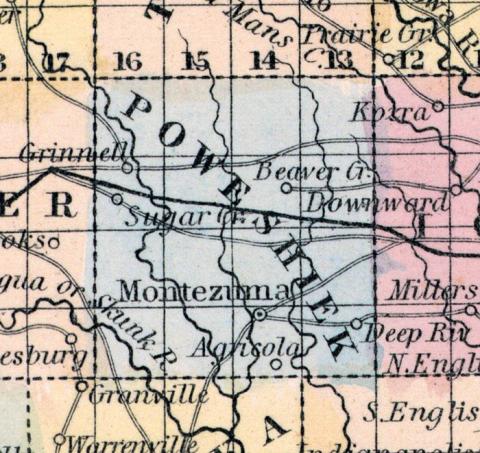GRINNELL In the winter of 1853 and '54, there appeared a notice in the New York Independent and Tribune, by Rev. J. B. Grinnell, then a Congregational Minister in New York, of his purpose to form a Christian colony and locate in the west. On the 8th of March, 1854, some four or five gentlemen met for the first time at the Park House, Iowa City, and consulted regarding this colony, and came to the conclusion that Iowa offered greater advantages to such a colony than any other State. Three of those present, the Rev. J. B. Grinnell, Dr. Thomas Holyoke, and Rev. Homer Hamlin, with a surveyor, Mr. Cassaday, of Iowa City, having procured a team, started out upon the Iowa City and Fort DesMoines road, with the consoling hint from the landlord, that it was doubtful whether they would find a stopping place short of Lattimore's Grove, seventy miles distant. As they journeyed west, the country was carefully observed, and inquiries made for a large tract of vacant land, but none was found on the first day, and night found them hospitably entertained with four beds in one room, more than they expected in so thinly settled a country. The next day at noon they arrived at Lattimore's Grove, having plats of all the land thereabout, they proceeded at once to take a view of the prairie where the town of Grinnell is now located, and finding it in all respects most desirable, determined here to plant the colony. As the neighboring inhabitants were suspicious of the colonists, believing them to be speculators, they determined immediately to have a shelter for new comers until the site for the town should be definitely located, and built a log camp. A considerable portion of the land in township 80, range 16 west, was entered by those present for their own use and for that of others who were soon to join them. In the early part of May, 1854, the site of the town was definitely fixed and located in the northwest quarter of section 16, township 80, range 16 west, and it was soon laid off into lots 75 feet by 165. The business street was to be 100 feet wide, all other streets 80 feet wide. A park was set apart near the centre for ornament, to be filled with shrubbery and trees. Six lots were set apart as the place for a church and school house. About the first of June, 1854, the first building was erected for the accomodation of the colonists and those who might choose to come that way, and they were not a few. This first building was put together for the time and occasion, and it chanced to be long, low and narrow, and thereby got the name of the “long home.” It was situated opposite to Deacon Bartlett's residence. At this stage of affairs the people voted to call the town Grinnell. Soon after the erection of this first building, another was erected, in whlch Mr. A. Scott kept store. A large stone or grout building was erected during the fall of the year for a hotel, and kept by George Chambers.
The next thing to be provided was a suitable place for holding religious meetings, and a school house. A small building was erected for this double purpose, and thus as ever the church and school go hand in hand; and it may be mentioned here that probably not a Sabbath has passed since the first location of the Colony, on which there has not been preaching or other religious services. Rev. J. B. Grinnell officiated as minister for the Colony part of the time during the first four years. In March, 1855, the initiatory steps toward forming a Congregational Church were taken, and the organization was perfected on the 8th of May, 1855. The church was organized with twenty members, and on the first of July, fourteen others joined the church. As education was one of the main-springs of the organization of the Colony, all funds arising from the sale of town lots over and above the original cost, were to be appropriated to this purpose, and in such a way as should be decided by the colonists themselves. One town lot was given to any one, whose purpose was to settle in the place, provided he built a good frame house, (a log house was never built on the town plat,) and having received one lot as a gift, the builder was expected to buy the adjoining lot, which he was always ready to do; and thus at present nearly every house has ample space for ornamental and garden purposes. During the year 1855, the balance of unentered land within ten miles of the town was mostly taken up, and the place increased considerably in population. The settlers were generally from the Eastern States. In the fall of this year, a large and commodious school house, 40x40 feet, and two stories high, was built. The first white child born in the Colony, was Frederick Samuel, a son of Dr. Thos. Holyoke, in April, 1855. He died the same year. The first death, was that of a Mr. Hale, an aged man, who died soon after his arrival in 1854. The first permanent frame dwelling house was built by Dr. Holyoke. In June, 1856, the Congregational Association of Iowa met here, and found a most cordial reception. Dr. Tappan, from Maine, who was present, made the remark, that he found here what he did not expect to find, a New England Colony as it were taken up by the roots and transplanted on the prairies of Iowa. On the 2d of April, 1857, the citizens laid the foundation to Grinnell University, which in time became Iowa College. (Hair's Iowa State Gazetteer..., 1865)
Annotations
Total Population 1860
392
Latitude
41.736699
Longitude
-92.724909
Type
City or Town
County
Poweshiek
State
Iowa

